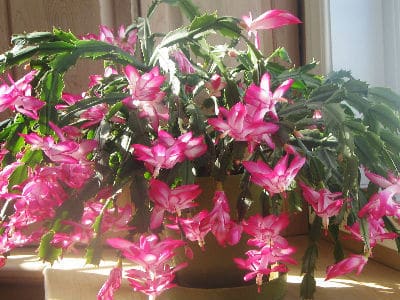Last updated on January 26th, 2022
Our site is reader supported, this means we may earn a small commission from Amazon and other affiliates when you buy through links on our site.
Repotting Christmas Cactus
Christmas Cactus is also known as the Schlumbergera plant. They originate from woodland-type areas where they attach themselves and grow on trees in a humid and moist environment. They make excellent, easy to grow, houseplants and are exceptionally popular because of their vivid show of beautiful colours from around November all the way through until January, making them ideal for a splash of colour over Christmas. They often make unique little Christmas gifts.
Eventually, these vigorous growing cacti will need repotting and potting up into a larger pot or container. They prefer to have their roots slightly crowded so don’t rush to pot them on too early. Once they are root bound and starting to look a little tired it is time to pot them on and give them a new lease of life. This will promote new healthy growth and will reward you with more stunning flowers, these are often red, pink, white, purple and lilac (to name a few depending on the variety). It is good to note that Christmas Cactus are usually just sold by their colour rather than the specific variety name.
When and how to pot on Christmas Cactus
Most houseplants are usually potted on in the spring when they begin actively growing, but ‘Schlumbergera’ are best potted up after they have finished flowering. This is usually around the end of January and into early February. As soon as the flowers have finished it is time to pot it on, assuming that it is root bound.
Generally, they only need repotting every 3-4 years, with the exception of cuttings or smaller young plants, as these may benefit from being repotted every year for the first couple of years until they are fully established.
A couple of days before repotting, we recommend that you water it ensuring the soil is moist if it is not already moist. This will reduce the stress on the plant when it is repotted.

How to pot on your Christmas Cactus
- Firstly ensure the pot you are going to use for your flowering cactus is only a couple of inches bigger around the edges than the pot it is already in. If you use a pot that is too big you run the risk of the plant getting root rot. Also make sure the pot has holes in the bottom so water can drain away freely.
- Use a compost suitable for cactus and succulents or make your own by using 50% normal potting compost and 50% grit sand. This will improve the drainage and help keep the soil damp but allow the compost to drain freely avoiding it being too wet because this is something they dislike.
- Put some of the compost into the new pot and then turn the cactus upside down in the palm of your hand gently removing the pot.
- Next, slightly tease the roots from the root bound plant being careful not to damage the roots as you do.
- Place the cactus in the new pot and gently put some compost around the side of the roots and firm down gently with your finger, ensuring compost is right around the roots. Don’t firm too hard as the roots may have difficulty rooting into the new compost. Your aim is to plant it at the same level as it was in the original pot.
Now all you need to do is give them a little water so the new compost is moist and place it in a cool room for a few days before returning to its original position.
Growing tips
- Christmas Cactus prefer moist soil, water freely between March and September and whilst in bud and flower. Reduce watering after flowering, only watering when the soil becomes dry.
- Place some pebbles in a bowl and fill with water and place the plant on top. This will help create the more humid enviroment that they prefer.
- Grow in a bright position but not in direct sunlight.
- They prefer to be kept at around 18-20°C (65-69°F) when in bud and flower before being moved to a slightly cooler 12-15°C (55-59°F) room after flowering.
- They benefit from being placed outside from around the end of May when the risk of first has passed before being brought indoors around September. This helps new growth mature and promotes more flowers.
- Take cuttings in May, they are very easy to take and propagate.

